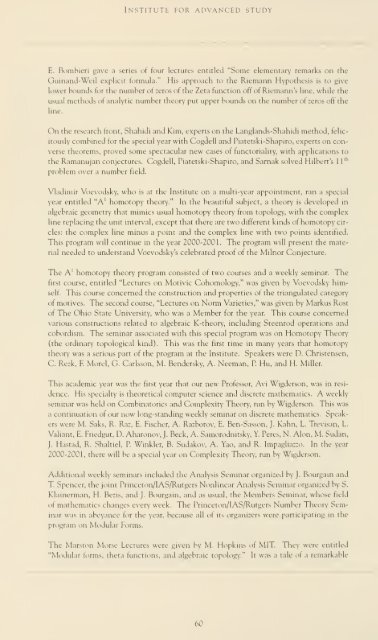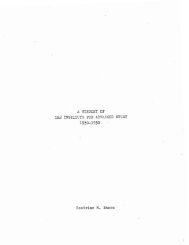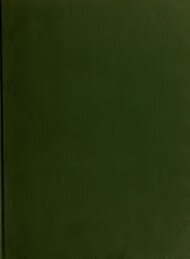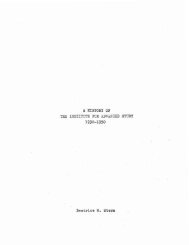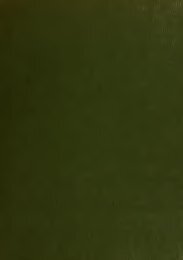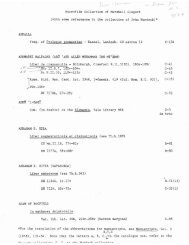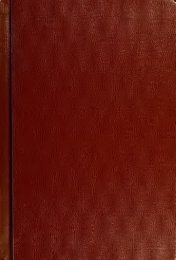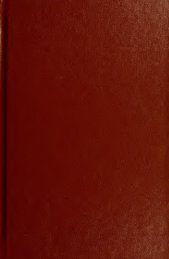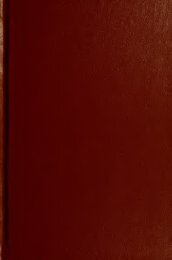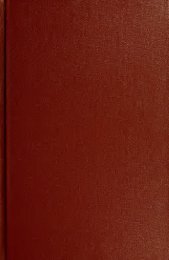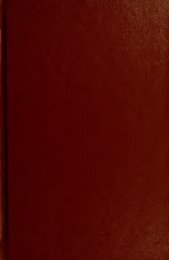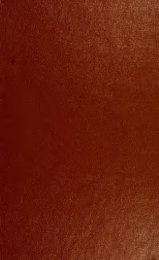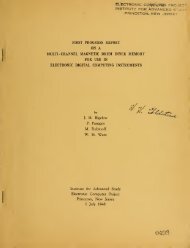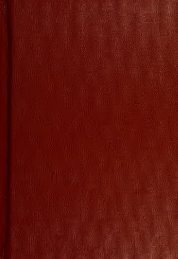Report for the academic year - Libraries - Institute for Advanced Study
Report for the academic year - Libraries - Institute for Advanced Study
Report for the academic year - Libraries - Institute for Advanced Study
Create successful ePaper yourself
Turn your PDF publications into a flip-book with our unique Google optimized e-Paper software.
<strong>Institute</strong> <strong>for</strong> advanced study<br />
[ Bombieri gave a series of four lectures entitled "Some elementary remarks on <strong>the</strong><br />
Guinand'Weil explicit <strong>for</strong>mula." His approach to <strong>the</strong> Riemann Hypo<strong>the</strong>sis is to give<br />
lower hounds <strong>for</strong> <strong>the</strong> number of zeros of <strong>the</strong> Zeta function oft of Riemann's line, while <strong>the</strong><br />
usual i methods il analytic number <strong>the</strong>ory put upper bounds on <strong>the</strong> number of zeros off <strong>the</strong><br />
line.<br />
On <strong>the</strong> research front, Shahidi and Kim, experts on <strong>the</strong> Langlands-Shahidi method, felic-<br />
itously combined <strong>for</strong> <strong>the</strong> special <strong>year</strong> with Cogdell and Piatetski-Shapiro, experts on con-<br />
verse <strong>the</strong>orems, proved some spectacular new cases of functoriality, with applications to<br />
,h<br />
<strong>the</strong> Ramanujan conjectures. Cogdell, Piatctski-Shapiro, and Sarnak solved Hilbert's 1 l<br />
problem over a number field.<br />
Vladimir Voevodsky, who is at <strong>the</strong> <strong>Institute</strong> on a multi-<strong>year</strong> appointment, ran a special<br />
<strong>year</strong> entitled "A' homotopy <strong>the</strong>ory." In <strong>the</strong> beautiful subject, a <strong>the</strong>ory is developed in<br />
algebraic geometry that mimics usual homotopy <strong>the</strong>ory from topology, with <strong>the</strong> complex<br />
line replacing <strong>the</strong> unit interval, except that <strong>the</strong>re are two different kinds of homotopy cir-<br />
cles: <strong>the</strong> complex line minus a point and <strong>the</strong> complex line with two points identified.<br />
This program will continue in <strong>the</strong> <strong>year</strong> 2000-2001. The program will present <strong>the</strong> mate-<br />
rial needed to understand Voevodsky's celebrated proof of <strong>the</strong> Milnor Conjecture.<br />
The A' homotopy <strong>the</strong>ory program consisted of two courses and a weekly seminar. The<br />
first course, entitled "Lectures on Motivic Cohomology," was given by Voevodsky him-<br />
self. This course concerned <strong>the</strong> construction and properties of <strong>the</strong> triangulated category<br />
of motives. The second course, "Lectures on Norm Varieties," was given by Markus Rost<br />
of The Ohio State University, who was a Member <strong>for</strong> <strong>the</strong> <strong>year</strong>. This course concerned<br />
various constructions related to algebraa K-<strong>the</strong>ory, including Steenrod operations and<br />
cobordism. The seminar associated with this special program was on Homotopy Theory<br />
(<strong>the</strong> ordinary topological kind). This was <strong>the</strong> first time in many <strong>year</strong>s that homotopy<br />
<strong>the</strong>ory was a serious pan ol <strong>the</strong> program at <strong>the</strong> <strong>Institute</strong>. Speakers were D. Christensen,<br />
C. Re:k, F. Morel, G. Carlsson, M. Bendersky, A. Neeman, R Hu, and H. Miller.<br />
This <strong>academic</strong> <strong>year</strong> was <strong>the</strong> first <strong>year</strong> that our new Professor, Avi Wigderson, was in resi-<br />
dence. His specialty is <strong>the</strong>oretical computer science and discrete ma<strong>the</strong>matics. A weekly<br />
seminar was held on Combinatorics and Complexity Theory, run by Wigderson. This was<br />
a continuation of our now long-standing weekly seminar on discrete ma<strong>the</strong>matics. Speak-<br />
ers were M. Saks, R. Ra:, E. Fischer, A. Razborov, H. Ben-Sasson, J. Kahn, L. Tfevisan, L.<br />
valiant, E. Friedgut, D. Aharonov.J. Beck, A. Samorodnitsky, Y. Peres, N. Alon, M. Sudan,<br />
1. Hast ad, R. Shaltiel, P. Winkler, B. Sudakov, A. Yao, and R. Impaglia::o. In <strong>the</strong> <strong>year</strong><br />
2000-2001, <strong>the</strong>re will be a special <strong>year</strong> on ( 'omplexity Theory, run In Wigderson<br />
Additional weekly seminars included <strong>the</strong> Analysis Seminal organized by 1<br />
Bourgain and<br />
n< er, <strong>the</strong> joint Princeton/IAS/Rutgers Nonlinear Analysis Seminar organized by S.<br />
Klainerman, II Bezis, and |. Bourgain, and as usual, <strong>the</strong> Members Seminar, whose field<br />
of ma<strong>the</strong>matics < hanges every week. The Princeton/IAS/Rutgers Number Theory Sem-<br />
inar was in abeyance tor <strong>the</strong> <strong>year</strong>, because all of its organizers were participating in <strong>the</strong><br />
mi on Modular Forms.<br />
The Marston Morse Lectures were given by ML Hopkins of MIT They were entitled<br />
"Modular tonus, <strong>the</strong>ta functions, and algebraic topology." It was a tale ot a remarkable<br />


